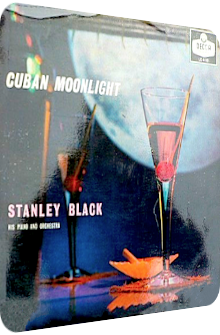
Stanley Black
Cuban Moonlight
1958
Cuban Moonlight is one of Stanley Black's (1913–2002) best-selling albums, originally recorded at the very end of 1957 and released in 1958 on Decca Records. It is usually linked to and bundled with the similarly titled Tropical Moonlight from 1957. While this British composer is also known for his skills as an arranger and conductor of large orchestras, it is his abilities as a pianist which are needed on this Cuban Jazz-themed album of 14 tracks. Two of them are written by Black himself, while the remaining twelve songs are takes on classic and less-known Latin material.
In contrast to his Exotica opus Exotic Percussion of 1961, Cuban Moonlight is much – and I mean much – more reduced, as all songs are played by a quartet of unknown session musicians; none of the players is mentioned in the liner notes of the LP. The big problem of this recording session is the focus on Black's piano. While later pieces by Martin Denny and the piano arrangements of Paul Conrad are equally narrowed down, it is the huge amount of fourteen songs that makes a problem out of this reduced setting. There is only a pair of bongos, some shakers and cymbals plus the occasional inclusion of an acoustic guitar included on each arrangement, and while such things are perfectly common and expected in the wide realms of Jazz, Exotica fans are usually residing in the comfort zone and hence used to much more vivid material complete with mallet instruments, paradisiac flutes or even the occasional bird call and drum solo.
None of these devices or peculiarities is featured on Cuban Moonlight, so the lack of instrumental variety causes a great deal of boredom if you listen to all fourteen songs in a row, which degrades the pitch-perfect and polished renditions to lackadaisical background music. There is of course a solution to this problem, but first, let me mention all of the 14 tracks in a somewhat briefer review than usual, for there is oftentimes not all that much to say about Stanley Black's gazillionth piano chord, no matter how effective it may be.
Vereda Tropical, now if that title doesn't promise an exotic cut, then I can't help it. Gonzálo Curiel's Latin piano arrangement is indeed vividly interpreted by Stanley Black, with the expected melodrama and conviviality delivered on this particular instrument that is later accompanied by vivid bongos and maracas. And that is already the whole secret of this composition, there is only one piano, a pair of bongos and two shakers involved, providing a welcome dose of minimalism that is seldom heard in the Exotica genre. Geo Bonnet's and Louis Gaste's Majorca is next and launches with a wonderful concoction of hollow bongos and clinging triangles. The classic joyful main melody is played on the piano, yet again presenting Black's stripped-down melody-focused approach with no disturbing elements. Still, I like Axel Stordahl’s take on Majorca off his first Exotica album Lure Of The Blue Mediterranean (1957) much better.
While Ernesto Lecuona's less featured composition Siboney consists of a latinized Honky Tonk piano and rapid-firing castanet-bongo couples which are later enhanced by mellow cymbals, it is Black's rendition of Osmán Pérez Freire's Ay-Ay-Ay that puts the catchy and occasionally even majestic piano to the forefront, with only the slightest accents of bongos and maracas. El Truco De Pernambuco by Manuel Salina is particularly noteworthy for two reasons, as it firstly opens Stanley Black's concept of trinity for the first time by adding a fourth instrument to the piano, bongos and shakers, namely a sun-lit acoustic guitar, and secondly due to its rhythmic shift near the end which revs up the presence of the shakers. Green Eyes by Nilo Menendez and Eddie Rivera offers more of the same Latin mannerism with particularly low and high piano notes, and the finishing track of side A, Rumba Matumba by Bobby Collazo features the fastest rhythms comprising of additional acoustic guitars, particularly blithesome and euphonious piano chords and a heavily spiraling but playful interlude.
Side B keeps the pace and doesn't offer anything new, or so it seems, as Black's interpretation of Gabriel Ruíz's Stars In Your Eyes surprises with clicking claves and polyphonous piano bursts. The percussion adds more depth to this song than on most of the other cuts and makes this a strong track that stands out from the rest, I believe. Ary Barroso's Os Quindins De Ya Ya continues to rely on the acoustic guitar as the fourth instrument and places it carefully in-between the muffled bongos, eminently icy shakers and piano melodies. While the take on Fred E. Ahlert's and Edgar Leslie's The Moon Was Yellow is probably the most familiar tune for Exotica fans and is presented here with both the wonky piano opening phase intact and the slightest breezes of the bongos and shakers, Nostalgia as well as Hold Me Close Tonight are unique compositions written by Stanley Black, the former presenting sunset-red piano notes that encapsulate a great amount of pompousness despite their jumpy nature, whereas the latter arrangement turns out to be the expected romantic ditty with enough room for the shakers to shine and to lessen the amorous notions a bit.
The final two songs are also well-known to Exotica experts who spent years and years of listening to their favorite genre: Xavier Cugat's and Alberto Dominguez's Perfidia presents a laid back rhythm with a particularly Latin piano flavor as well as microscopic hints of the acoustic guitar, with the final Frenesi co-written by Dominguez with Leonard Whitcup ends the album on a joyful note with staccato bongos and the world-famous melody played in higher regions. Having been interpreted very recently by Mr. Ho's Orchestrotica in the style of Juan García Esquivel, Frenesi is one of the songs that remain stuck in the head, regardless of the arrangement or artist.
Cuban Moonlight is a double-edged sword due to its reduced setup and narrow thematic focus. Its plus side can immediately cause a negative reaction of the prototypical Exotica fan who is interested in Latin music due to the many encounters one has with the genre thanks to the various interpretations of Exotica quartets or symphonic orchestras. And that is exactly the junction where Stanley Black's 14 cuts come into play: his humble and reduced approach remains true to the origins of these Latin classics, but gets boring rather quickly. If the only surprise levels consist either of rhythm shifts or the inclusion of a fourth instrument, the album is quickly degraded to lackluster background music. While this was and still is one of the tasks of both Exotica and Latin music – providing an accentuating soundscape for a cocktail party or a celebratory evening with selected friends – in general, Cuban Moonlight offers short-lived, ephemeral renditions.
Never does the quartet led by Black branch out or come up with a truly interesting interpretation. And yet does this reduction serve an interesting counterpoint to the symphonic versions which usually degrade the Latin spirit. Black is much closer to the core, and indeed do some of his arrangements depict moon-lit sceneries. While the album succeeds in quantity, the quality-related aspects suffer, as the arrangements are painfully similar to each other. In smaller doses, the material is charming, but listening to all fourteen takes is a waste of time and bores the hell out of me, I'm afraid. Exotica fans and Latin fellows alike should carefully choose from the presented roster and only consider two or three tracks per party or evening. You don't miss anything if you skip the album entirely though, and are much better served by Percy Faith's much more varied and gemstone-laden Cuban LP Malagueña of 1958 anyway.
Exotica Review 155: Stanley Black – Cuban Moonlight (1958). Originally published on Dec. 8, 2012 at AmbientExotica.com.
